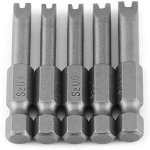The center nut is used to "range" the lever, such that it can tightened at an appropriate angle. People use torque wrenches to get a predictable pre-load on a fastener. The relationship between torque and pre-load is dependent upon the thread pitch, wet vs dry threads, rust, etc. In particular, lubing the threads has a tremendous effect - I'm surprised the various ring manufacturers dont specify wet vs dry. With the very fine thread utilized in rings, it is very easy to strip threads through over-tightening. Over the years, I've run across this on various used rifles I have bought - particularly on aluminum rings.
OP - In your case, the pitch of the throw lever cam establishes the relationship between torque and pre-load, along with other parameters such as lubrication. Using recommendations from other ring manufacturers is limiting. Case in point, the Burris Z-ring relies upon substantial pre-load to actually pinch the solid ring closed. Only a small fraction of the torque is used to secure the ring to the base - a poor design IMHO.
I would guess that the throw lever cam has a very shallow pitch, which allows the convenience of finger tight (wet), even with arthritic hands. After all, they are quick-release...











































































